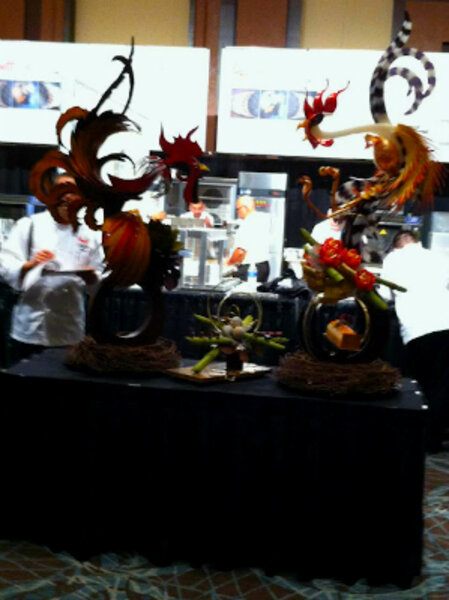2012 World Pastry Championship
Loading...
I just got back from a mini vacation – I went to the 2012 World Pastry Championship in Las Vegas, N.V. It's been on my bucket list for over 10 years to watch the competition in person and I finally, finally was able to go. It's held every other year and when it's not the World Pastry Championship, it's the National Pastry Championship for the US teams.
But this year was the world competition and the teams competing were from Japan, Mexico, South Korea, Netherlands, China, and USA. This is the Olympics of the pastry world. And there certainly were some Olympian chefs there.
Check out the link so you can see what the competition is about – each team has 13 hours, spread over 2 days, to come up with a set of plated desserts to be judged on Day 1 then a sugar showpiece, a chocolate showpiece and petits gateaux for Day 2. And trust me, this is no easy feat. These chefs are amazing, every single one of them. I am no expert but during culinary school, I did enough sugar work and chocolate work to know how hard it is and the kind of skill you have to have to even make it to this competition. It takes years of experience and practice. Some teams practiced for the 13-hour competition with as many as 30 or more 13-hour practice runs of their own for a year and a half. Imagine that kind of dedication in addition to doing your day job.
Day 1 was mostly a lot of prep for Day 2 although they did complete the plated desserts in time for judging. It was fascinating to watch the chefs in action. No movements were wasted, it wasn't the flurry and drama you sometimes see on Food Network (ahem, "Chopped," "Cupcake Wars," etc); instead everything was streamlined efficiency. As soon as one task was done, they began another. They were also judged on how they worked and it was impressive to see sponge cakes being made (often the base for the plated desserts) swiftly, wrapped up, station cleaned, then pastry cream – make, wrap, put away, clean – then mousses and fillings. Each member of the team had their own jobs to do and they were focused.
There are various teams of judges and various elements of the competition being judged. Not just the finished products in terms of taste and appearance but also the way they did their work. The taste judging is done "blind" with each team getting assigned a number. The judges don't know which team's products they're judging and their backs are to the team kitchens when they sample the desserts.
Each team must produce:
- 1 sugar showpiece
- 1 chocolate showpiece
- 1 sugar/chocolate amenity presentation piece for displaying bonbons on buffet table
- 14 identical plated desserts
- 3 different types of chocolate bonbons
- 3 identical entremets
- 3 identical entremets glace
- 3 different types of petits gateaux
The highlight of the competition is always the showpieces at the end. Each team has to create one showpiece made of sugar and one of chocolate. This year's theme was astrology and it was interesting to see how each team interpreted that for their showpieces. There are very strict rules in terms of the type of shapes they can use and what equipment is permissible or not. They also must transport their showpieces from their stations to the display table. Many a heart has been broken when a showpiece shatters.
My pictures do not do these showpieces any justice. They're much more impressive in person. The lighting was poor in some places and it was difficult to get a clean shot of the displays with so many people around. You can't exactly ask a judge blocking the display table to step aside during their judging so you could take a good picture. Bear in mind, each showpiece is made out of entirely chocolate or entirely sugar, nothing else, rendering them even more incredible.
South Korea was heartbreaking because in transporting their chocolate showpiece, half of it fell off. They could only put the other half out for judging. Then shortly after the judging began, the sugar showpiece toppled.
As a spectator, I could only get close enough to the teams on the ends to really see what they were working on. Team Japan was on one end but they had a large contingent of supporters so it was hard to get really close. Team USA had the most supporters because of the competition's home-country location so it was also hard to squeeze in on that end but I got lucky a couple of times and managed to get up close.
I saw their sugar rooster "come to life" before my eyes and it was nothing short of amazing. On Day 1, I could see all the elements being put together but since I didn't know what they were building, it was hard to picture it. But once it did all come together, literally before my eyes, it was beyond mind-boggling that what you see above is all made out of sugar. Sugar, water and some food coloring. Astonishing. Hats off to all the chefs in the competition.
I didn't stay for the awards dinner and I'm still waiting for the website to be updated but I believe I heard Team USA won! Based on showpieces alone, I would've gone with either Team Japan or Team USA so I'm glad one of my top 2 favorites took the championship.








